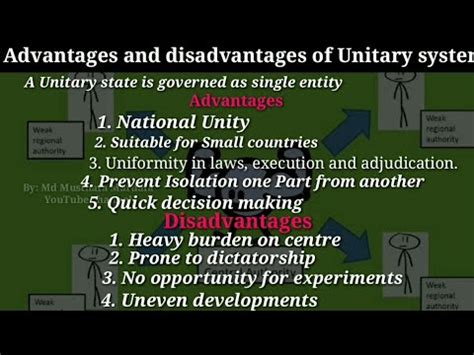In a unitary government, the central authority holds primary power, with subnational units (such as states or provinces) having limited autonomy. This centralized structure offers various advantages and drawbacks that shape its effectiveness and suitability for different societies.

Advantages of a Unitary Government
1. Efficient Decision-Making:
Unitary governments allow for swift and decisive decision-making, as power is concentrated at the national level. This streamlining enables the government to respond quickly to national emergencies and implement policies effectively.
2. Consistency in Policy:
The absence of subnational autonomy ensures that policies are applied consistently throughout the country. This uniformity promotes equality and prevents regional disparities in development or service provision.
3. Strong National Unity:
A unitary system fosters a sense of national unity by eliminating regional cleavages. The central authority serves as a unifying force, promoting shared values and common goals among citizens.
4. Economic Integration:
The lack of regional barriers simplifies economic integration within a unitary government. The central authority can implement policies that facilitate free trade, encourage investment, and promote economic growth.
5. Effective Resource Allocation:
Centralized decision-making enables the government to efficiently allocate resources based on national priorities. This reduces wastage and ensures that funds are directed towards the most pressing needs.
Disadvantages of a Unitary Government
1. Limited Local Autonomy:
Subnational units have limited powers and autonomy in a unitary system. This can stifle local initiatives and make it difficult for regions with distinct needs to address their unique challenges.
2. Potential for Tyranny:
The concentration of power at the central level can lead to tyranny or authoritarianism. The absence of checks and balances on the national government increases the risk of abuse of power.
3. Suppression of Minority Interests:
In highly diverse societies, a unitary government can marginalize minority groups by suppressing their cultural or linguistic rights. The lack of regional autonomy limits their ability to preserve and celebrate their identities.
4. Inequality in Representation:
Unitary systems may have difficulty ensuring fair representation for all regions, especially in vast or geographically diverse countries. This can lead to imbalances in power and resource allocation.
5. Lack of Innovation:
The centralized structure of a unitary government can stifle innovation at the local level. Subnational units may lack the resources and authority to experiment with new ideas or implement innovative solutions.
Table 1: Comparison of Advantages and Disadvantages
| Aspect | Advantages | Disadvantages |
|---|---|---|
| Decision-Making | Swift and efficient | Limited local autonomy |
| Policy Consistency | Uniform policies | Regional disparities |
| National Unity | Strong sense of unity | Suppression of minority interests |
| Economic Integration | Simplified economic integration | Inequality in representation |
| Resource Allocation | Efficient allocation | Lack of innovation |
Table 2: Advantages for Different Societies
| Society Type | Advantages |
|---|---|
| Small and Homogeneous | Efficient decision-making, strong national unity |
| Large and Diverse | Limited local autonomy, potential for tyranny |
Table 3: Disadvantages for Different Societies
| Society Type | Disadvantages |
|---|---|
| Small and Homogeneous | Limited innovation, inequality in representation |
| Large and Diverse | Suppression of minority interests, marginalization of subnational units |
Table 4: Key Motivations for Unitary Governments
| Motivation | Examples |
|---|---|
| Promote National Unity | Countries with a history of regional conflict or fragmentation |
| Boost Economic Growth | Countries seeking to achieve rapid economic development and integration |
| Strengthen Central Authority | Countries that prioritize security or stability in the face of external threats |
FAQs
1. What is the primary difference between a unitary and a federal government?
In a unitary government, power is concentrated at the national level, while in a federal government, power is shared between the national government and subnational units.
2. Is a unitary government more efficient than a federal government?
In terms of decision-making, unitary governments are generally more efficient, but they may lack the flexibility and local autonomy of federal systems.
3. What are the risks associated with a unitary government?
Potential risks include tyranny, suppression of minority rights, and inequality in representation.
4. How can a unitary government balance the need for national unity with local autonomy?
Effective decentralization measures, such as devolving certain powers to subnational units, can strike a balance between these two objectives.
5. Is a unitary government more suitable for small or large countries?
Unitary governments are typically more appropriate for smaller, homogeneous countries, while federal governments are better suited for large, diverse countries.
6. What are the key factors to consider when designing a unitary government?
Factors such as the size, diversity, and history of the country must be taken into account when designing a unitary government.
7. How can a unitary government promote economic development?
Centralized decision-making and streamlined economic policies can facilitate economic integration and stimulate growth.
8. What are the challenges of implementing a unitary government in a diverse society?
Ensuring fairness, protecting minority rights, and addressing regional disparities can be challenging in a unitary system.
